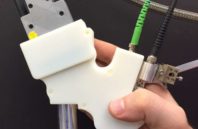Researchers have developed and demonstrated the first handheld ophthalmology instrument with resolution-boosting adaptive optics technology that can image individual photoreceptors in the eye. The new portable instrument will allow improved diagnosis of eye diseases and could enable early detection of brain-related diseases and trauma.
In Optica, The Optical Society’s journal for high impact research, the researchers report their new light-weight instrument, which measures just 10 by 5 by 14 centimeters. They tested the device in children and adults, demonstrating its ability to capture images of even the very small photoreceptors close to the center of the retina that play a key role in vision.
Photoreceptors, specialized neurons that convert light entering the eye into signals sent to the brain, are the only neurons in the body that can be imaged non-invasively. Imaging photoreceptors is not only important for diagnosing eye diseases but could also provide insights into processes occurring in the brain. Preliminary studies have shown that changes in the retina can be observed during the early stages of diseases such as Alzheimer’s and after traumatic brain injuries such as concussions.

 (585) 768-2513
(585) 768-2513

